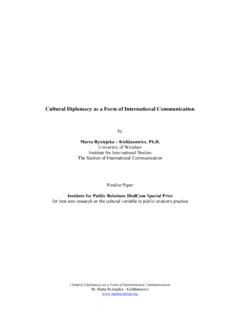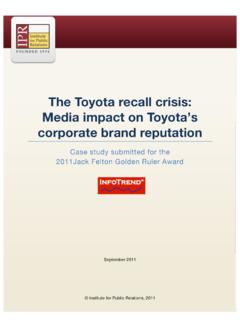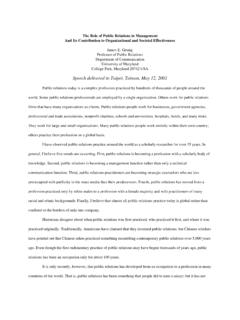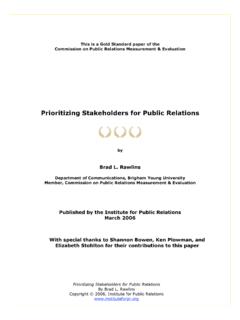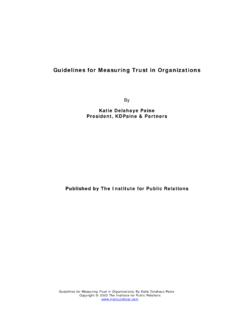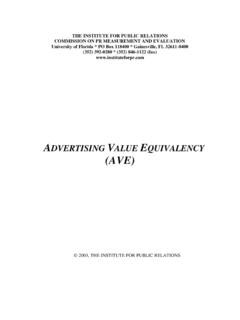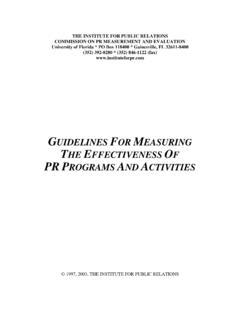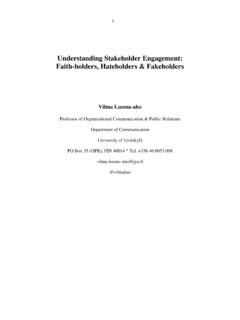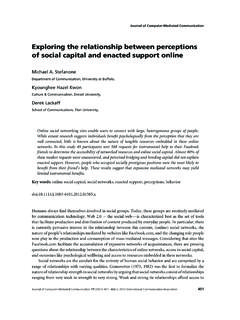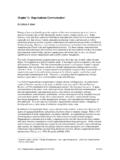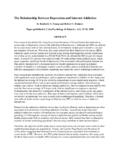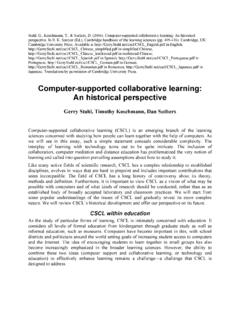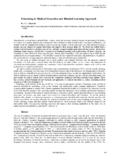Transcription of INTERNAL COMMUNICATION, INFORMATION …
1 INTERNAL communication , INFORMATION satisfaction AND SENSE OF COMMUNITY: THE EFFECT OF PERSONAL INFLUENCE Candace White, Ph. D. University of Tennessee Antoaneta Vanc University of Tennessee Gina Stafford University of Tennessee Key words: employee communication , INTERNAL communication , personal influence, public relations 2 INTERNAL communication , INFORMATION satisfaction AND SENSE OF COMMUNITY: THE EFFECT OF PERSONAL INFLUENCE ABSTRACT This study examined how employees of a large, diverse organization view the flow of INFORMATION from top managers in positions of personal influence, employees communication preferences (amount, channels, types of INFORMATION ), their sense of community within the organization, and the relationship between those perceptions and their willingness to advocate for the organization. Previous studies that have explored the personal influence model of public relations have considered it from a boundary-spanning perspective, focusing on an individual practitioner s relationship with other strategic individuals in the external environment.
2 Personal influence can be equally important for INTERNAL communication , where employees are the strategically targeted public. Open-ended interviews with 147 employees at all levels permitted respondents to answer in depth, and allowed the researchers to probe for useful insights. Findings indicate that the personal influence of the CEO and top managers has an effect on INFORMATION satisfaction , and consequently how employees speak about the organization to external stakeholders. Employees at all levels who have a relationship with the CEO are more satisfied with the INFORMATION they receive and feel a greater responsibility to advocate for the organization. Even the perception of a relationship with the CEO leads to communication satisfaction . The direction dimension of INTERNAL communication , as well as the channel dimension is important. While email is efficient for INFORMATION exchange, the preference for communication among all groups of employees is still face-to-face interaction.
3 Interpersonal, dialogic communication remains important to employees at every level of the organization. Meetings, despite being acknowledged as time-consuming, were surprisingly valued as a channel for feedback and providing face time with top managers. Electronic channels, if used thoughtfully, can flattened the traditional, hierarchical structure of INTERNAL communication and can give employees at all levels of the organization the sense of hearing things first-hand, from the top. 3 INTRODUCTION INTERNAL communication has been recognized as a strategic focus for business communication , second only to leadership concerns (Barnfield, 2003). Jo and Shim (2005) note that given the emerging paradigm of public relations by relationship management, the terms of INTERNAL communication need to be redefined as part of building favorable relationships between management and employees (p.)
4 278). Managers within organizations are in a role of personal influence in their relationships with employees. Numerous studies have linked INTERNAL communication and the degree to which employees are informed to job satisfaction and performance (Gray & Laidlaw, 2002; Bartoo & Sias, 2004; Rosenfeld, Richman & May, 2004; Zucker, 2002). The competitive advantage of strategic INTERNAL communication comes not only from the obvious benefits of employee satisfaction and productivity, but also from the positive contributions that well-informed employees can make to a company s external public relations efforts. Employees can be an organization s best ambassadors or loudest critics, depending whether and how they get INFORMATION (Howard, 1998). Effective INTERNAL communication can enhance corporate reputation and credibility, since employees are viewed as particularly credible sources by external stakeholders (Dawkins, 2004; Hannegan, 2004).
5 Put simply, employees are the face of an organization and have a powerful influence on organizational success. The purpose of this study was to explore employees perception of the flow of INFORMATION from top managers in positions of personal influence, employees communication preferences (amount, channels, types of INFORMATION ), their sense of community within the organization, and the relationship between those perceptions and their willingness to advocate for the organization. Qualitative approaches are preferable when the goal of the research is to understand a process or phenomenon, since surveys give respondents fixed choices, which forces them to respond to questions that otherwise might not be relevant to them. Inductive qualitative methods allow themes to emerge from the data that may not have been considered a priori by the researchers.
6 Therefore, in-depth telephone interviews 4 that allowed open-ended responses were conducted with employees in a large university with locations across the state. While universities are unique organizations, they have commonalities with other large and diverse organizations. The president or chancellor is the CEO, and other administrators (vice presidents, provosts, deans) represent the dominant coalition or top management team. Faculty are the professional staff and mid-level managers (directors, department heads) found at the center of organizations. Other employees are workers that range from administrative assistants to computer experts to custodians. The similarities to other complex organizations are greater than the differences, making the findings applicable to a variety of types of large organizations. LITERATURE REVIEW An important role of strategic INTERNAL communication is to generate buy-in for an organization s goals and strategies.
7 No matter how brilliant the business strategy, it must reach and win employees to achieve optimum effectiveness. Employees want to know where their organization is headed and how they contribute to achieving the vision (Moorcroft, 2003). Employees need a core story that consistently puts strategy into the context of the mission and values of the organization (Sanchez, 2004). Personal influence inside organizations It is widely acknowledged that the CEO sets the tone for INTERNAL communication (Schein, 2000; Tourish and Robson, 2003). The leader of an organization is automatically the designated chief communication officer, and successful INTERNAL communication is impossible without CEO support, because successful companies lead through effective top-down communication (Van Nostran, 2004, p. 10). Haas (2006) found the greatest desire from employees in a variety of types of organizations was for more INFORMATION from top management, and most employees believe face-to-face communication with supervisors is the most desirable channel.
8 Jo and Shim (2005) found a strong relationship between management s interpersonal communication and employees forming trusting attitudes. Cameron and McCollum (1993) also found that employees preferred interpersonal communication with management over mediated communication . In short, employees want to see and talk to their leaders. 5 Top managers in an organization are in a role to exert strong personal influence in their relationships with other employees and to affect attitudes, job satisfaction , and consequently how employees speak about the organization to external stakeholders. Personal influence is an important component of relational communication . Toth (2000) believes that interpersonal communication is at the core of the personal influence model of public relations, and suggests that the public influence model could be more aptly called the individual influence model since the power of personal influence lies in the status, trustworthiness, and credibility of the individual.
9 Most studies that have explored the personal influence model of public relations have considered it from a boundary-spanning perspective, focusing on practitioners relationships with external stakeholders such as journalists and government officials. Personal influence can be equally important for INTERNAL communication , where employees are the strategically targeted public. As background, the personal influence model of model of public relations, first identified by Grunig, Grunig, Sriramesh, Huang, and Lyra (1995), referred to public relations practitioners personal relationships with key individuals in media, government, politics, or activist groups who could affect the success of public relations efforts. Further evidence of the model was found by Sriramesh, Kim, and Takasaki (1999). In their study, personal influence was used by practitioners as a quid pro quo favor-granting and favor-gaining role.
10 In the Asian cultures in their study, personal influence sometimes relied on social class and power. Jo and Shim (2002) also found that personal relationships played a critical role in media relations in South Korea where personal influence was often used to mitigate negative media stories. While not always labeled as personal influence, evidence of the phenomenon has been found in the practice of public relations in Western societies. Grunig, et al. (1995) provide examples of personal influence, which include former government officials working in firms in which their influence is a commodity, as well as other examples of practitioners providing favors and contacts. Toth (1988) found that chemistry and personal relationships between clients and practitioners was important in the decision to hire external public relations agencies, even when the decision was more expensive or inconvenient.
